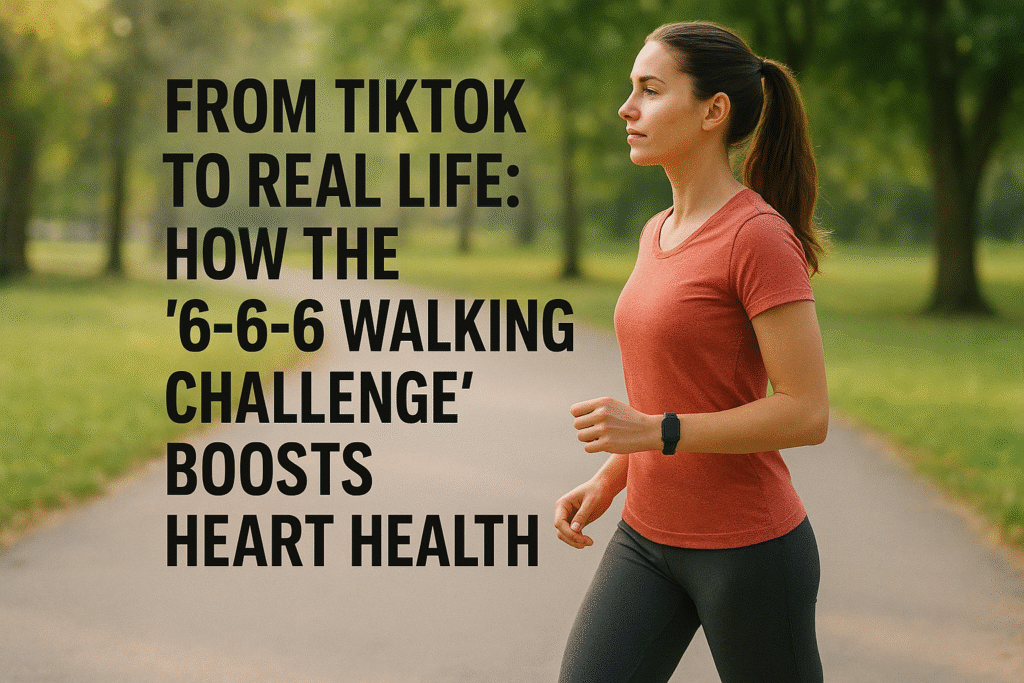The 6-6-6 Walking Challenge is taking TikTok by storm. But does it actually work? We dive into the science behind this viral trend to show you how walking 6,000 steps in 60 minutes, 6 days a week, can dramatically improve your cardiovascular fitness, mental health, and overall well-being.
When a Viral Trend Meets Real Science
Another day, another health trend on TikTok. From bizarre concoctions to questionable workouts, the platform is a double-edged sword of wellness information. But every so often, a trend emerges that is not only simple and accessible but is also backed by a surprising amount of scientific evidence. Enter the 6-6-6 Walking Challenge.
The rules are straightforward, almost deceptively simple:
- Walk 6,000 steps
- In 60 minutes (or less)
- For 6 days a week
It has flooded feeds with hashtags like #666Challenge, accompanied by clips of people power-walking through parks, on treadmills, and around their neighborhoods, often with impressive before-and-after results. But is this just social media hype, or is there a legitimate physiological reason this specific formula is so effective?
This article cuts through the viral noise. We will dissect the 6-6-6 Walking Challenge component by component, exploring the robust science that explains why this particular combination of duration, frequency, and intensity is a potent prescription for heart health, weight management, and mental clarity. Forget the fads; this is a sustainable, evidence-based strategy that turns a simple walk into a powerful tool for transformation.
Deconstructing the Challenge – The Power of Specifics
The genius of the 6-6-6 Walking Challenge lies in its specific parameters. It’s not a vague “walk more.” It’s a precise protocol that combines key exercise principles.
1. The 6,000-Step Target: Beyond the Baseline
We’ve all heard the generic “10,000 steps a day” goal. While a great aspiration, it can feel daunting and is somewhat arbitrary in origin (it was initially a Japanese marketing slogan for a pedometer). For many, hitting 10,000 requires a significant time commitment that isn’t always feasible.
- The Science of 6,000: Research has consistently shown that benefits begin well before 10,000. A seminal study published in The Lancet found that 6,000 steps per day was a key threshold for adults aged 60+. At this level, participants saw a significantly reduced risk of cardiovascular disease. For younger adults, 6,000 steps is an achievable yet challenging daily bout of exercise that provides a substantial health stimulus on top of baseline activity.
2. The 60-Minute Time Cap: Introducing Intensity
This is the most critical component. The challenge isn’t to meander 6,000 steps throughout the day. It’s to complete them in a focused, 60-minute window. This transforms a casual stroll into brisk walking or power walking.
- The Pace Calculation: 6,000 steps in 60 minutes equates to a pace of 100 steps per minute. This pace is firmly in the category of moderate-intensity aerobic activity, as defined by the CDC and ACSM. Your breathing should be noticeably deeper, your heart rate elevated, and you should be able to talk in short sentences, but not sing.
- The Heart Rate Zone: This moderate-intensity pace places you in a heart rate zone (roughly 50-70% of your max) that is ideal for improving cardiovascular endurance, boosting stroke volume (the amount of blood pumped per beat), and enhancing your body’s ability to use oxygen (VO2 max).
3. The 6-Day Frequency: The Sweet Spot for Consistency
Exercising 6 days a week provides an optimal balance of stimulus and recovery.
- Building a Habit: Frequency is key to habit formation. Doing something 6 times a week quickly integrates it into your daily routine, making it an automatic behavior rather than a chore.
- Maximizing Caloric Expenditure: This frequency creates a significant weekly caloric deficit, which is crucial for weight management and improving metabolic health markers like insulin sensitivity.
- Active Recovery: Unlike high-impact activities, brisk walking is low-impact and can be performed on consecutive days without a high risk of overtraining. The 7th day of rest allows for full musculoskeletal recovery.
Together, these three “6”s create a perfectly balanced exercise prescription that is both effective and remarkably sustainable.
The Heart of the Matter – Cardiovascular Benefits Unveiled
The 6-6-6 Walking Challenge is, at its core, a cardiovascular workout. Its impact on heart health is profound and multi-faceted.
1. Lowering Blood Pressure:
Moderate-intensity aerobic exercise, like brisk walking, is a first-line defense against hypertension. It helps:
- Improve Endothelial Function: The endothelium is the inner lining of your blood vessels. Exercise makes it more flexible and efficient at dilating, which reduces peripheral resistance and lowers blood pressure.
- Strengthen the Heart Muscle: A stronger heart can pump more blood with less effort, decreasing the force on your arteries.
2. Improving Cholesterol Profile:
Regular brisk walking has a positive effect on your blood lipids:
- Increases HDL (“Good”) Cholesterol: HDL acts as a scavenger, carrying LDL away from the arteries and back to the liver.
- Lowers LDL (“Bad”) Cholesterol and Triglycerides: Exercise helps your body process and remove fats from the bloodstream.
3. Enhancing Circulation and Reducing Arterial Stiffness:
As we age, our arteries can become stiffer, a major risk factor for heart disease. The rhythmic, sustained effort of the challenge promotes blood flow and helps maintain arterial elasticity.
4. Boosting Heart Rate Variability (HRV):
HRV is a marker of your nervous system’s resilience and your heart’s ability to adapt to stress. A higher HRV is associated with better cardiovascular health and lower stress. Consistent moderate exercise is one of the most effective ways to improve HRV.
Beyond the Heart – The Holistic Health Payoff
While heart health is the star, the benefits of the 6-6-6 Walking Challenge ripple throughout the entire body and mind.
1. Sustainable Weight and Fat Loss:
Completing 6,000 brisk steps burns a significant number of calories (approximately 300-400 for an average person). Done 6 days a week, this can create a weekly deficit of 1800-2400 calories—the equivalent of over half a pound of fat loss per week, a healthy and sustainable rate.
2. Dramatically Improved Mental Health:
This is a benefit many participants report first.
- Stress Reduction: Rhythmic aerobic exercise lowers levels of the body’s stress hormones, such as adrenaline and cortisol.
- Endorphin Release: It stimulates the production of endorphins, the brain’s natural mood elevators and pain killers. This is the famed “runner’s high,” accessible at a walking pace.
- Reduced Anxiety and Depression: Numerous studies place exercise on par with medication for treating mild to moderate depression and anxiety. The combination of physiological changes, time outdoors, and a sense of accomplishment is a powerful tonic for the mind.
3. Enhanced Metabolic Health:
Brisk walking makes your muscles more sensitive to insulin. This means your body is better at moving glucose from your bloodstream into your cells to be used for energy, helping to regulate blood sugar and prevent insulin resistance, the precursor to Type 2 diabetes.
4. Joint Health and Longevity:
Unlike running, walking is low-impact, making it joint-friendly. It lubricates joints and strengthens the supporting muscles, which can reduce pain from conditions like arthritis. Large-scale studies consistently link regular walking with increased life expectancy.
How to Start and Succeed – Your Practical Guide to the 666 Challenge
Ready to begin? Here’s how to implement the challenge safely and effectively.
Step 1: Gear Up (You Don’t Need Much!)
- Shoes: The most important investment. Choose supportive walking or running shoes, not fashion sneakers.
- Apparel: Wear moisture-wicking clothes for comfort.
- Tech (Optional): A smartphone with a health app (Apple Health, Google Fit) or a basic pedometer/fitness tracker is perfect for counting steps.
Step 2: Assess Your Baseline
Don’t jump straight to 6,000 steps in 60 minutes if you’re new to exercise.
- Test Your Pace: Go for a walk and see how many steps you can complete comfortably in 15 minutes. Multiply by 4 to get your current hourly step count.
- Use the “Talk Test”: Ensure you are in the moderate-intensity zone. You should be able to hold a conversation but be slightly breathless.
Step 3: progressive overload is key
Use a gradual approach to avoid injury and build endurance.
- Week 1: Aim for 4,000 steps in 45 minutes, 4-5 days a week.
- Week 2: Aim for 5,000 steps in 50 minutes, 5 days a week.
- Week 3: Attempt the full 6,000 steps in 60 minutes, for 6 days.
Step 4: Stay Motivated
- Find a Buddy: Accountability is a powerful motivator.
- Listen to Podcasts/Audiobooks: Make it a time for learning and entertainment.
- Explore New Routes: Keep the scenery fresh to prevent boredom.
- Track Your Progress: Use an app to see your streaks and improvements, which can be highly motivating.
Important Considerations and Safety
- Consult Your Doctor: If you have any pre-existing health conditions, are over 40, or have been sedentary, get clearance from your physician before starting any new exercise program.
- Listen to Your Body: Some muscle soreness is normal. Sharp pain is not. Stop if you feel any acute pain.
- Stay Hydrated: Drink water before, during (if needed), and after your walk.
- Warm-Up and Cool-Down: Spend 3-5 minutes walking slowly at the start and end of your session to prepare your muscles and prevent stiffness.
Conclusion: A Step in the Right Direction
The 6-6-6 Walking Challenge is a rare phenomenon: a viral trend with genuine substance. Its popularity isn’t based on a gimmick but on a simple, potent formula that aligns perfectly with established exercise science. It democratizes fitness, making a highly effective workout accessible to nearly everyone, regardless of age, fitness level, or access to a gym.
By committing to this challenge, you are doing more than just walking. You are engaging in a daily ritual that strengthens your most vital muscle, clears your mind, manages your weight, and builds a foundation for a longer, healthier life. In a world of complex health advice, the most powerful solution might just be lacing up your shoes and hitting your step goal. The path to better health is literally right outside your door.


